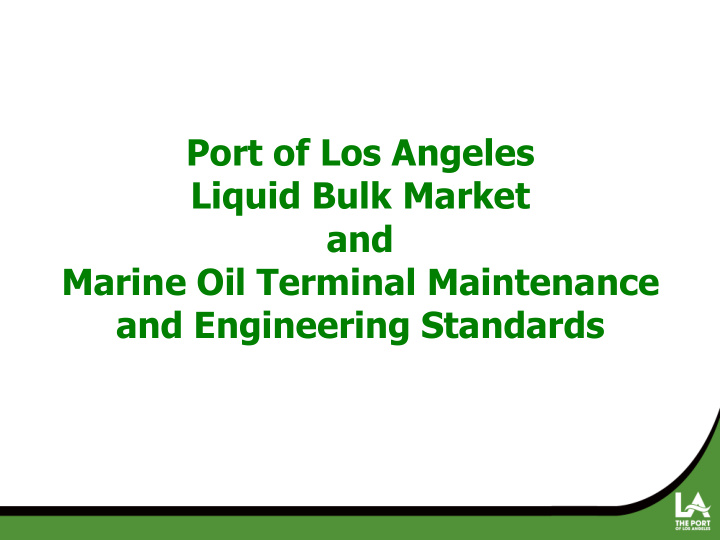



Port of Los Angeles Liquid Bulk Market and Marine Oil Terminal Maintenance and Engineering Standards
Port of Los Angeles Marine Oil Terminals Terminal Capacity and Business Structure • 7 marine oil terminals • 154 million barrels per year throughput capacity • 8.2 million barrels of storage in Port • Berths • 8 panamax (-37 to -40) • 1 aframax (- 45’) • Tenants/Operators • 3 Proprietary Refiners (ExxonMobil, Phillips 66, Valero) • 4 Third Party Logistics (Kinder Morgan, NuStar, Shell, Vopak)
Port of Los Angeles Marine Oil Terminals Terminal Connectivity Efficient pipeline connectivity with all major refiners and third • party logistics providers Commodity handling capability for dark and clean products • Crude oil • Fuel oil • Gas oil • Lube oil • Gasoline • Diesel • Jet fuel • Ethanol •
Regional Refineries
POLA Liquid Bulk Terminals
West Basin Kinder Morgan
Phillips 66
Mormon Island Shell, Valero, NuStar
Vopak
ExxonMobil
Market Drivers • Bunker Fuel – Fuel Oil • Market stabilization since 2013 • Significant year over year increases since 2013 • IMO Regulation 2020-2025 • Gasoline • Jet Fuel • Crude Oil • Shifting market sources • Limits on exporting domestic crude • Widening of Panama Canal (2016) • KinderMorgan Trans Mountain Pipeline Expansion (2018)
Historic Volumes
History 1919 to Present • Average California terminal wharf age = 50 yrs. • Average Port of LA terminal wharf age= 79 yrs. • Original Terminal Design • Designed for 20,000 bbls. barges • Now accepting 200,000 to 400,000 bbls. vessels • Coastal Oil Spills • Exxon Valdez (Alaska)- 1989 • American Trader (Huntington Beach, CA)- 1990 • Concern Regarding Resiliency of Marine Oil Terminals • Seismic • Tsunami • Risk of spills • Development of MOTEMS •
Results and Concerns
Results and Concerns
Results and Concerns
Existing Mooring Operations
MOTEMS Compliant Mooring Operations
Berthing Operations MOTEMS Compliant Existing Condition
MOTEMS (Marine Oil Terminal Engineering and Maintenance Standards) • California State Lands Commission is the agency responsible for implementation • Standardized Criteria for Existing Operations • Periodic Audit and Inspection (3 to 4 year cycle) • Required maintenance and upgrades • Operational restrictions pending redevelopment • Long Term Compliance • Retrofit or rebuild new • Significant capital costs
MOTEMS Program Planning • MOTEMS Facility Plan - 2011 • Current business needs and opportunities • Market projections • Terminal capacity and constraints • Wharf, Pipelines, Tankage, Pumping • Strategic Initiatives • Increase utilization of existing • Minimize capital expenditures
MOTEMS Implementation Process • Initial Approach – Consolidation (2012) • Tenant relocations and Refiner consolidation • Reduce total berths from 12 to 8 Revised Approach – (2013) • • No relocation or refiner consolidation • Vopak reconfiguration Implementation Adjustments (2013-2015) • • Plains All American Pier 400 project cancelled (2013) • Vopak to remain at current location (2015)
Current Status • Negotiations 2012 – 2015 (6 tenants) • 2 term sheets signed • 4 term sheets in negotiations • Development 2016 - 2020 • Current Negotiation Issues • Market conditions and escalating project costs • Project scope validation • Schedule goal to complete all negotiations by end of 2015 - Begin EIR preparation 1Q 2016
Questions
Recommend
More recommend